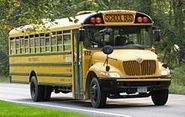 Preventing and Managing Rodents in School
Buses and Garages
Although wildlife is
a natural and important part of our ecosystem, rodents such as mice and squirrels can pose a
safety risk by damaging wiring and hoses of vehicles. Damage and droppings can
pose health, structural and fire risks to maintenance buildings and garages,
too. Here are some tips to prevent and manage rodents in and around buses and
garages. Additional recommendations
to prevent and manage wildlife problems are available on-line from Maine Inland
Fisheries and Wildlife Department, or contact your regional IF&W regional
biologist, or contact a licensed wildlife control operator (find one near you
at https://www.maine.gov/ifw/fish-wildlife/wildlife/wildlife-human-issues/index.html#ADC).
1. Park buses as far
from trees and heavy vegetation as possible. If you need to remove trees or
prune large overhanging branches, hire a licensed arborist to ensure safe
removal. Avoid parking near dumpsters, too.
2. Seal all food in pest-proof
(air-tight) containers. Empty food waste cans, clean up crumbs and wrappers and
wash down floors and seats at the end of the day. Leave no food or food waste
for night-active rodents.
3. Conduct daily vehicle hood-lift and walk-through
safety inspections before use. The use of a bright flashlight is highly
recommended. Inspect
wiring for gnawing damage, look for and remove nests and/or caches of acorns
and leaves. Signs of rodents or rodent
damage should be addressed immediately.
4. Identify the
pest(s). Droppings, gnaw marks, footprints, nests, or visual sighting of the
animal itself can be helpful. A game camera set up to record animal activity can
be helpful.
5. Inspect the outside
of buildings for possible entryways. Look for gnawed holes, small gaps around
pipe and utility penetrations, missing soffit covers, gaps in the siding or
masonry or other openings in walls, foundation and roof. After removing the
animals, seal the holes with galvanized hardware cloth, steel wool, aluminum
flashing. Rodents will readily gnaw through foam sealants.
6. When a new or persistent wildlife problem occurs, work
with pest management and wildlife management professionals to develop an
effective management approach. This may include the use of live traps,
snap traps, repellents, and/or approved pesticides to temporarily address the
issue. Snap traps are often effective for mice and rats. Cage traps are better
for larger animals. Follow your professional's recommendations for trapping and euthanizing the
animals. For rats, bait the traps for a week to let the rat get
used to the trap before setting it.
7. Keep records of all
pest sightings (including droppings, gnawing damage, nests) and actions taken
in your school’s Pest Activity Logbook. Communicate with your IPM Coordinator,
maintenance staff, and pest service provider following your schools’ established
communication system. In addition, keep written records in the logbook and make
sure that the pest control technician has access to your records and that you
have access to theirs. Keeping all the records in one place will ensure that
everything is documented and communicated.
photo: By Die4kids - Own work, CC BY-SA 3.0, https://commons.wikimedia.org/w/index.php?curid=24903387
|